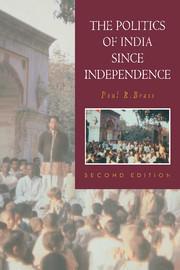Book contents
1 - Introduction: continuities and discontinuities between pre- and post-Independence India
Published online by Cambridge University Press: 05 February 2015
Summary
India arrived at Independence after a long struggle and with a multiplicity of heritages and legacies which influenced its post-Independence course in complex ways. Among the legacies were the long experience of British rule itself, which extended back more than two centuries, and of the various institutions, ideas, and practices, introduced by the British. Of particular importance at Independence was the Government of India Act of 1935, which was the most recent framework of rule under which the country was governed and which included a considerable measure of responsible government for Indians in the provinces. A second legacy was that provided by the shared experience of those Indians who participated in or identified with the nationalist movement and its great leaders. A third was the existing social order, the social structure and social conflicts which surrounded and influenced political movements, ideas, and practices. Finally, there was the great body of traditions and cultural practices which preceded British rule in a civilization of great depth, complexity, and diversity.
THE CONSTITUTION AND THE COLONIAL LEGACY
In some ways, it is possible to view Independence and the adoption in the early years after Independence of a new Constitution as another stage in the evolution of India toward representative government in a process that dates back to the Indian Councils Act of 1861 and continues through the Morley-Minto Reforms of 1909, the Montagu-Chelmsford Reforms of 1919, and the Government of India Act of 1935. At each of these reforms, the participation of Indians in the central and state legislatures and in the executive councils was increased and the franchise was extended to ever larger numbers of people.
It has often been noted especially that there was a considerable degree of continuity between the Government of India Act and the Constitution of India. The features of continuity included the adoption of a federal system of government with three legislative lists of powers to be exercised exclusively by the Union, exclusively by the states, or concurrently, and a combination of a considerable degree of provincial autonomy with extensive powers left to the Center, including emergency powers which made it possible to convert the federal system into a unitary one.
- Type
- Chapter
- Information
- The Politics of India since Independence , pp. 1 - 28Publisher: Cambridge University PressPrint publication year: 1994
- 1
- Cited by

